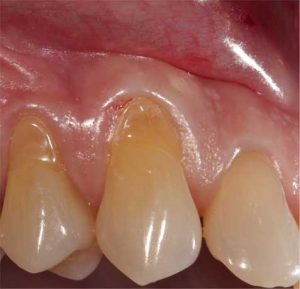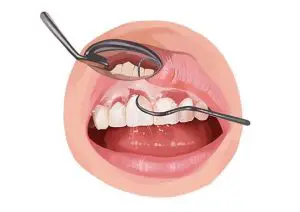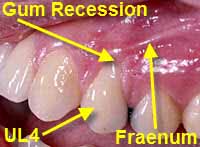Table of Contents
Gum Graft Overview
A gum graft is a dental procedure, is done if your gum is receding. Receding your gum exposes the root of your teeth that can lead to teeth decay.
Gum is recommended if the dentist finds any sign of gum receding. If the receding gum isn’t corrected, that can cause teeth to root abrasion, decay, hypersensitivity, and even bleeding.
Your dentist can refer you to a periodontist because it’s a simple surgical procedure.
What is a Gum Graft?
A gum graft is also known as gingival graft. In this procedure, the dentist or periodontist removes a piece of tissue from the roof of your mouth or other healthy gum areas. Then place the healthy tissue in the area where the gum has been worn or receding.
Therefore, it is quite a simple surgical procedure and can be done in the outpatient department or dentist chamber.
It takes less time, and you can leave for home as soon as the procedure is done.
Who Needs Gum Graft?
A gum graft is recommended when there is gum receding. Multiple causes can lead to gum receding.
- Poor oral hygiene – It is the main cause of gum receding. Poor oral hygiene provides a helpful oral environment for microbial colonization. Bacteria take about 24 hours to create a colony inside our mouth. If you miss brushing a single day, that is even enough for bacterial colonization.
- Excessive brushing – Excessive brushing can also lead to gum recession. Not following the proper technique of brushing is another cause. Suppose you use a hard brush and use roughly. It can cause damage to your gum, and that may lead to gum recession.
- Sensitive teeth – Gum recession exposes your teeth roots. So, your teeth will be sensitive to cold water, temperature, and certain foods.
- Teeth Bleeding – Gum recession can cause bleeding at the root level. Your teeth are not anymore safe. They can easily be infected.
One should visit a dentist at least once every six months for dental prophylaxis. If the doctor finds gum recession, he may recommend you a gum graft.
The more time you take to feel that you have gum issues, the more dangerous it will be.
Highly infective teeth may also need a gum graft with a root canal if the situation demands.
If you feel any discomfort in your teeth or feel anything unusual, visit a dentist. He’ll choose the perfect treatment plan for you.
Read Dental Surgery | Dry Socket
Preparation For Gum Graft Surgery
There are three types of gum grafts available. The dentist will evaluate your condition and recommend you the best option.
- Connective tissue grafts
- Free gingival grafts
- Pedicle grafts
After visiting a dentist, he will discuss these options with you and recommend you the best option.
You don’t have to change your diet or lifestyle for this procedure. Just make sure your mouth is clean, and you brushed your teeth properly on the day of surgery.

It is a simple surgical procedure, and you can go home after the surgery is done. Make sure there is someone who can drive you back.
Make sure you’ve taken all of your medical certificates and history to the dentist for better treatment.
Gum Graft Surgery Procedure
There are three types of gum grafts. The dentist performs the best option that is suitable for you.
Connective Tissue Grafts Procedure
It is the most common method of gum graft. In this procedure, the dentist cuts the skin from the roof of your mouth (palate) and collects tissue from under the flap, which is known as subepithelial connective tissue.
Then place it in the exposed root. After collecting the tissue, the dentist stitches the area.
Free Gingival Grafts Procedure
In this procedure, the dentist collects tissue directly from the roof of your mouth without creating a flap.
This procedure is usually done when your gum is thin and needs extra tissues to make it thick and more protective.
Free gingival gum grafts prevent further recession of thin gum.
Pedicle Grafts Procedure
This procedure is the most effective procedure amongst all types of gum grafts.
In this procedure, the dentist creates a flap of tissue near the area of gum recession. Next, he pulls the flap of tissues over the exposed root and covers them. After that, the dentist stitches the area.
This procedure requires a high amount of gum tissues near the area of gum recession.
If you fill the criteria of this method, your dentist may recommend you this method.
Pedicle grafts method is the less invasive and more effective gum graft method.
Gum Graft Recovery
You can go home after the procedure is done. You may feel mild discomfort in your gum area. The dentist may prescribe you pain medications and sedatives to relax.
Sometimes the dentist may ask you to wait one or two hours after the procedure for close observations.
Make sure you have someone to drive you back home.
The doctor will provide you specific instructions to follow during the recovery period. These instructions may include;
- Taking soft meals and liquids for some days.
- Avoiding hard foods during the recovery period.
- Avoiding certain foods.
- Proper brushing technique for the recovery period.
- Medications
- Avoiding certain activities
- Avoiding specific exercises
Eating hard foods can damage your gum. For example, hot food can burn the gum graft during recovery, and spicy foods can irritate.
Example of foods that is suitable for you;
- Eggs
- Soft cooked vegetables
- Yogurt
- Cheese
- Icecream (not so cold)
- Jelly
- Soft bread etc.
The doctor may prescribe you antimicrobial mouthwash to prevent infection in the gum area. You have to avoid brushing and flossing in that area to prevent damage.
The doctor may also prescribe you antibiotic ointment.
Is Gum Graft Painful?
It depends on the methods of gum graft. If the dentist collects tissue from your palate. Then you may feel little pain.
If the dentist follows the pedicle draft method, then you may not feel any pain.
Palate pain is not severe. You’ll feel a little discomfort, and it’s typically fade away after some days.
The doctor may prescribe you over-the-counter pain medications.

Recovery Period of Gum Graft Surgery
It takes one to two weeks for a full recovery. After that, you can continue your general activity without any problems.
The dentist may recommend a follow-up visit after one or two weeks to ensure your healing process is done.
Emergency Situations
- Unusual bleeding
- The bleeding continued even after applying pressure
- Any sign of infections
- Unusual pain or swelling
- Any sign of bruise or abrasion.
Contact your doctor right away if you experience any of them.
Possible Risks And Complications
A gum graft is an essential and safe procedure. The complications and infections are rare.
If you see any sign of infection, talk to your doctor.

Sometimes, the gum graft may not suit to site. You may need another surgery to make it right.
If you feel anything unusual after the healing, talk to your doctor. You may need another gum reshaping surgery to get the perfect result.
Gum Graft Cost
The average cost for a gum graft surgery is $700 – $1000. However, it may vary according to your location and your teeth conditions.
Some additional fees may include;
- Anesthesia fee
- Medication cost
- Test costs
Talk to your doctor about the total cost of the procedure. Many insurances cover the cost of the gum graft. In addition, some hospital provides EMI facilities.
Who Needs Another Gum Graft?
Sometimes the gum graft can not adapt properly and fall of. In that case, you may have to undergo gum graft surgery to get the best outcome.
If you do not follow proper oral hygiene, you can experience gum recession again on the same teeth along with other teeth.

Maintaining proper oral hygiene can prevent those complications.
Proper oral hygiene include;
- Brushing twice a day
- Flossing
- Rinsing the mouth with antimicrobial mouth wash
- Dental prophylaxis twice a year
- Eating healthy foods
- Avoiding extreme hard foods
- Using fluoride-containing toothpaste
- Using soft brush
- Quit smoking
Gum Graft Summery
A gum graft is a surgical procedure done by a dental surgeon. This procedure is recommended when there is gum recession.
In this procedure, the surgeon collects healthy tissue from other parts of your mouth and place it in the affected area.
Gum graft surgery is a safe and effective procedure with minimal side effects.
You have to maintain proper oral hygiene to prevent further gum recession after the surgery.
Frequently Asked Questions (FAQs)
How much does a gum graft cost?
A gum graft costs an average of 700 – 1000 USD. It varies according to your location, previous medical condition, teeth and gum condition, etc.
How long before I can eat normally after gum graft?
It takes about one or two weeks to get fully recovered from a gum graft. After the healing period, you can continue your regular food habit and lifestyle.
What to expect after gum graft surgery?
You may have little discomfort or pain after the surgery. The doctor may prescribe you pain medications. After the healing period you can continue your regular lifestyle and there won’t be any pain.
What is a gum graft?
A gum graft is a surgical procedure to treat gum recession. In this procedure, the dentist collects healthy tissue from other parts of your mouth and place it in the affected gum area.
Last Updated on February 23, 2022 by Learn From Doctor Team





